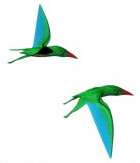Nemicolopterus
| Nemicolopterus Temporal range: Early Cretaceous, 120 Ma | |
|---|---|
 | |
| Scientific classification | |
| Kingdom: | Animalia |
| Phylum: | Chordata |
| Class: | Reptilia |
| Order: | †Pterosauria |
| Suborder: | †Pterodactyloidea |
| Clade: | †Azhdarchoidea |
| Genus: | †Nemicolopterus Wang et al., 2008 |
| Type species | |
| †Nemicolopterus crypticus Wang et al., 2008 | |
Nemicolopterus is a genus of pterodactyloid pterosaur described in 2008. N. crypticus is the type species and sole species known. The generic name "Nemicolopterus" comes from the following Greek words: "Nemos" meaning "forest", "ikolos" meaning "dweller", and "pteros" meaning "wing". The specific name crypticus is from "kryptos", meaning "hidden". Thus "Nemicolopterus crypticus" means "Hidden flying forest dweller". It lived in the Jehol Biota 120 million years ago.
N. crypticus is known from a single fossil, catalog number IVPP V-14377, in the collection of the Institute of Vertebrate Paleontology and Paleoanthropology in Beijing, China. The fossil was collected from the Jiufotang Formation, which is of Aptian age (120 mya). It was discovered in the Luzhhouou locality of Yaolugou Town, Jianchang County, Huludao City, western Liaoning Province in northeastern China.
The wingspan of slightly under 25 centimeters (10 in) makes N. crypticus smaller than all but a few specimens of hatchling pterosaurs.[1] The specimen is not fully grown, but Wang et al. (2008) cite the amount of bone fusion and the ossification of the toes, gastralia and sternum as indicating that it was a sub-adult rather than a hatchling. Darren Naish argued on his popular weblog that, due to the fact pterosaurs are highly precocial, bone fusion and ossification could occur very early, and Nemicolopterus might in fact be a hatchling individual of the genus Sinopterus.[2]
Nemicolopterus is a toothless pterosaur. Wang et al. (2008) concluded that it is a primitive intermediate between the Pteranodontoidea and the Dsungaripteroidea. Though Nemicolopterus is tiny, some of the members of these groups eventually evolved into the largest flying animals that ever lived, such as Quetzalcoatlus.
Nemicolopterus also demonstrates clear adaptations of the toes and claws for grasping tree branches. Most pterosaurs are known from marine sediments, meaning that they probably caught fish in the ocean and landed on the adjacent beaches or cliffs. Nemicolopterus, on the other hand, is one of just a few known pterosaurs that lived in the continental interior, and probably hunted insects and roosted in the forest canopy. It is worthwhile, however, to note that the contemporaneous pterosaur lineage Tapejaridae (such as Sinopterus, which might be synonymous with Nemicolopterus) also shows strong adaptations to climbing.[3]
See also
References
- ↑ Wang, X., Kellner, A.W.A., Zhou, Z., and Campos, D.A. (2008). "Discovery of a rare arboreal forest-dwelling flying reptile (Pterosauria, Pterodactyloidea) from China." Proceedings of the National Academy of Sciences, 106(6): 1983–1987. doi:10.1073/pnas.0707728105
- ↑ Darren Naish, Tiny pterosaurs and pac-man frogs from hell, March 19, 2008
- ↑ artist's depiction
External links
- Preliminary skeletal restoration by paleoartist John Conway
- Sparrow-Sized Pterodactyl Was Smallest Ever